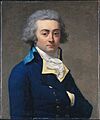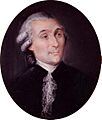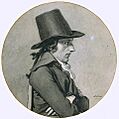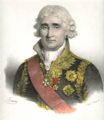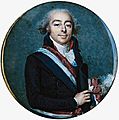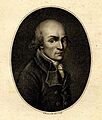List of presidents of the National Convention facts for kids
Quick facts for kids President of the National Convention |
|
|---|---|
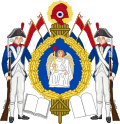 |
|
| National Convention | |
| Style | Citizen President |
| Seat | Salle du Manège, Paris |
| Term length | 14 days |
| Formation | 20 September 1792 |
| First holder | Jérôme Pétion de Villeneuve |
| Final holder | Jean Joseph Victor Génissieu |
| Abolished | 26 October 1795 |
From September 1792 to November 1795, France was led by the National Convention. The person in charge was called the President. This leader was chosen from within the Convention for a short, two-week term. During this time, France was known as the French Republic.
Historians often divide the Convention's time into three main parts: a moderate period, a radical period, and a reaction period. The leaders of the Convention changed their policies to match these different times. Some presidents lost their lives during the radical and reaction phases. Others were sent away from France later on.
Contents
Starting the National Convention
The National Convention was the government of France during a very important part of the French Revolution. It ruled from September 20, 1792, to October 26, 1795.
The members of the National Convention were chosen in September 1792. Many nobles and people who didn't support the Republic chose not to vote. Also, people were afraid. Because of this, not many people voted, even though more people were allowed to vote than before.
The Convention's main job was to create a new constitution. This was needed after the king was overthrown on August 10, 1792. The Convention had 749 members. These members came from different jobs, like law, journalism, medicine, and business.
One of their first big decisions was to officially end the monarchy (rule by a king). This happened on September 21. The very next day, September 22, the Republic was officially started. The Convention also created a new calendar. It started counting time from September 22, 1792, as the first day of "Year One" of the Republic. This new calendar removed all Christian holidays.
The Convention chose a new president every two weeks. A president could be chosen again after two weeks had passed. Meetings usually happened in the morning. But often, they also had evening meetings that lasted late into the night. Sometimes, the Convention would stay in session for days without stopping.
To make laws and manage the country, the Convention used special groups called committees. These committees had different levels of power. The most well-known committees were the Committee of Public Safety and the Committee of General Security.
The Convention had both the power to make laws and the power to carry them out. It went through three main phases:
- Girondins (moderate): This group wanted a republic that favored business owners. They also wanted to limit the power of Paris over the revolution.
- Montagnard (radical): This group wanted poorer people to have more political power.
- Thermidorian (reaction): This phase came after the radical period.
A big uprising in Paris from May 31 to June 2, 1793, led to the Girondins losing their power in the Convention. After this, the Montagnards took control.
During the Montagnard phase (June 1793 to July 1794), France was at war and had internal rebellions. This led the government to create the Committee of Public Safety. This committee had almost complete power. Because of this, a new democratic constitution that was approved in June 1793 was never actually used. The Convention itself lost much of its power to make new laws.
The Montagnards became powerful as the Girondins lost influence. The Girondins had struggled to decide what to do with King Louis XVI after he tried to escape France. Some Girondins thought they could still use the king as a symbol. But the Montagnards were united. They strongly supported executing the king during his trial in late 1792 and early 1793. After this victory, the Montagnards worked to make the Girondins look bad. They called them liars and enemies of the Revolution.
The end of 1793 and early 1794 was a time of great conflict. It was called the Reign of Terror. During this period, there was a lot of violence between rival political groups, especially the Girondins and the Jacobins. Many people who were seen as "enemies of the revolution" were arrested or removed from power.
In the third phase, called Thermidor, many members of the Convention removed the most powerful leader of the Committee of Public Safety, Maximilien Robespierre. This was a reaction against the extreme power of the Committee. It brought power back to the more moderate members of the Convention. The Girondins who had survived the earlier changes were brought back. Many leading Montagnards were themselves removed from power.
In August 1795, the Convention approved a new constitution. This led to a new government called the Directory. The Directory was mostly controlled by wealthy citizens. It ruled from 1795 to 1799. Then, Napoleon Bonaparte took power in a coup d'etat.
Moderate Phase (1792–1793)
At first, a group called La Marais, or The Plain, had the most control in the Convention. This group was moderate and didn't have very strong opinions.
At the very first meeting on September 20, 1792, an older statesman named Philippe Rühl was in charge. The next day, the idea to "abolish royalty in France" was put forward. Everyone cheered when it passed. On September 22, news arrived that the Republic had won a battle. On the same day, the Convention decided that all official documents would be dated "First Year of the French Republic." Three days later, they added that "the French republic is one and indivisible." This was to make sure France stayed united.
The following men were chosen for two-week terms as presidents of the Convention during this moderate time:
| Image | Dates | Name | Fate |
|---|---|---|---|
 |
20 September 1792 | Philippe Rühl | Died May 29/30, 1795 |
 |
20 September 1792 – 4 October 1792 | Jérôme Pétion de Villeneuve | Died June 18, 1794 |
 |
4 October 1792 – 18 October 1792 | Jean-François Delacroix | Lost his life April 5, 1794 |
 |
18 October 1792 – 1 November 1792 | Marguerite-Élie Guadet | Lost his life June 17, 1794 |
 |
1 November 1792 – 15 November 1792 | Marie-Jean Hérault de Séchelles | Lost his life April 5, 1794 |
 |
15 November 1792 – 29 November 1792 | Henri Grégoire | Died May 28, 1831 |
 |
29 November 1792 – 13 December 1792 | Bertrand Barère de Vieuzac | Died January 13, 1841 |
 |
13 December 1792 – 27 December 1792 | Jacques Defermon des Chapelières | Died June 20, 1831 |
 |
27 December 1792 – 10 January 1793 | Jean-Baptiste Treilhard | Died December 1, 1810 |
 |
10 January 1793 – 24 January 1793 | Pierre Victurnien Vergniaud | Lost his life October 31, 1793 |
 |
24 January 1793 – 7 February 1793 | Jean-Paul Rabaut Saint-Étienne | Lost his life December 5, 1793 |
 |
7 February 1793 – 21 February 1793 | Jean-Jacques Bréard, dit Bréard-Duplessis | Died January 2, 1840 |
 |
21 February 1793 – 7 March 1793 | Edmond Louis Alexis Dubois-Crancé | Died June 29, 1814 |
 |
7 March 1793 – 21 March 1793 | Armand Gensonné | Lost his life October 31, 1793 |
 |
21 March 1793 – 4 April 1793 | Jean Antoine Joseph Debry | Died January 6, 1834, Paris |
| 4 April 1793 – 18 April 1793 | Jean-François-Bertrand Delmas | Disappeared August 19, 1798 | |
 |
18 April 1793 – 2 May 1793 | Marc David Alba Lasource | Lost his life October 31, 1793 |
 |
2 May 1793 – 16 May 1793 | Jean-Baptiste Boyer-Fonfrède | Lost his life October 31, 1793 |
 |
16 May 1793 – 30 May 1793 | Maximin Isnard | Died March 12, 1825 |
 |
30 May 1793 – 13 June 1793 | François-René-Auguste Mallarmé | Died July 25, 1835 |
By the end of May 1793, an uprising by the working-class people of Paris, called the sans culottes, greatly weakened the power of the moderate Girondins. Even though Danton and Hérault de Séchelles served as presidents one more time each, the Girondins had lost control. Over the summer, the revolution changed from being led by the middle class to being led by the working class. New rules were put in place, like price controls and a guaranteed minimum wage for workers and soldiers. The government became much more revolutionary.
Radical Phase (1793–1794)
After the uprising, any attempts to resist the new revolutionary ideas were stopped. The events of May 31 to June 2, 1793, were a big turning point in the French Revolution. During these days, the Girondin party lost power. This happened because of pressure from the Parisian sans-culottes, the Jacobins (a political club), and the Montagnards in the National Convention.
The following men were chosen as presidents of the Convention as it moved from its moderate to its radical phase:
| Portrait | Name (Born–Died) |
Term of office | Political party | |||
|---|---|---|---|---|---|---|
| Took office | Left office | Time in office | ||||
 |
Jean-Marie Collot d'Herbois (1749–1796) |
13 June 1793 | 27 June 1793 | 14 days | The Mountain | |
 |
Jacques Alexis Thuriot de la Rosière (1753–1829) |
27 June 1793 | 11 July 1793 | 14 days | The Mountain | |
 |
Andre Jeanbon Saint Andre (1753–1813) |
11 July 1793 | 25 July 1793 | 14 days | The Mountain | |
 |
Georges Jacques Danton (1759–1794) |
25 July 1793 | 8 August 1793 | 14 days | The Mountain | |
 |
Marie-Jean Hérault de Séchelles (1759–1794) |
8 August 1793 | 22 August 1793 | 14 days | The Mountain | |
The following men were chosen as presidents of the Convention during its main radical phase:
| Portrait | Name (Born–Died) |
Term of office | Political party | |||
|---|---|---|---|---|---|---|
| Took office | Left office | Time in office | ||||
 |
Maximilien Robespierre (1758–1794) |
22 August 1793 | 5 September 1793 | 14 days | The Mountain | |
 |
Jacques Nicolas Billaud-Varenne (1756–1819) |
5 September 1793 | 19 September 1793 | 14 days | The Mountain | |
 |
Pierre Joseph Cambon (1756–1820) |
19 September 1793 | 3 October 1793 | 14 days | The Mountain | |
| Louis-Joseph Charlier (1754–1797) |
3 October 1793 | 22 October 1793 | 19 days | The Mountain | ||
| Moïse Antoine Pierre Jean Bayle (1755–1815) |
22 October 1793 | 6 November 1793 | 15 days | The Mountain | ||
| Pierre-Antoine Lalloy (1749–1846) |
6 November 1793 | 21 November 1793 | 15 days | The Mountain | ||
 |
Charles-Gilbert Romme (1750–1795) |
21 November 1793 | 6 December 1793 | 15 days | The Mountain | |
 |
Jean-Henri Voulland (1751–1801) |
6 December 1793 | 21 December 1793 | 15 days | The Mountain | |
 |
Georges Auguste Couthon (1755–1794) |
21 December 1793 | 5 January 1794 | 15 days | The Mountain | |
 |
Jacques-Louis David (1748–1825) |
5 January 1794 | 20 January 1794 | 15 days | The Mountain | |
 |
Marc Guillaume Alexis Vadier (1736–1828) |
20 January 1794 | 4 February 1794 | 15 days | The Mountain | |
 |
Joseph-Nicolas Barbeau du Barran (1761–1816) |
4 February 1794 | 19 February 1794 | 15 days | The Mountain | |
 |
Louis Antoine de Saint-Just (1767–1794) |
19 February 1794 | 6 March 1794 | 15 days | The Mountain | |
 |
Philippe Rühl (1737–1795) |
7 March 1794 | 21 March 1794 | 14 days | The Mountain | |
 |
Jean-Lambert Tallien (1767–1820) |
21 March 1794 | 5 April 1794 | 15 days | The Mountain | |
 |
Jean-Baptiste-André Amar (1755–1816) |
5 April 1794 | 20 April 1794 | 15 days | The Mountain | |
 |
Robert Lindet (1746–1825) |
20 April 1794 | 5 May 1794 | 15 days | The Mountain | |
 |
Lazare Carnot (1753–1823) |
5 May 1794 | 20 May 1794 | 15 days | The Mountain | |
 |
Claude-Antoine Prieur-Duvernois (1763–1832) |
20 May 1794 | 4 June 1794 | 15 days | The Mountain | |
 |
Maximilien Robespierre (1758–1794) |
4 June 1794 | 19 June 1794 | 15 days | The Mountain | |
| Élie Lacoste (1745–1806) |
19 June 1794 | 5 July 1794 | 16 days | The Mountain | ||
| Jean-Antoine Louis (1742–1796) |
5 July 1794 | 19 July 1794 | 14 days | The Mountain | ||
Reaction Phase (1794–1795)
On July 27, 1794, the National Convention decided to arrest Maximilien Robespierre, Louis Antoine de Saint-Just, and their supporters. They were removed from power the next day. This event marked the end of the most radical part of the French Revolution.
The following men were presidents of the Convention until it ended:
| Image | Dates | Name | Fate |
|---|---|---|---|
 |
19 July 1794 – 3 August 1794 | Jean-Marie Collot d'Herbois | Died June 8, 1796 |
 |
3 August 1794 – 18 August 1794 | Philippe Antoine Merlin, dit Merlin de Douai | Died December 26, 1838 |
 |
18 August 1794 – 2 September 1794 | Antoine Merlin de Thionville | Died September 14, 1833 |
 |
2 September 1794 – 22 September 1794 | André Antoine Bernard, dit Bernard de Saintes | Died October 19, 1818 |
 |
22 September 1794 – 7 October 1794 | André Dumont | Died October 19, 1838 |
 |
7 October 1794 – 22 October 1794 | Jean-Jacques-Régis de Cambacérès | Died March 8, 1824. He was one of the few members of La Marais to become President. He also helped write Napoleon's Civil Code. |
 |
22 October 1794 – 6 November 1794 | Pierre-Louis Prieur, dit Prieur de la Marne | Died May 31, 1827 |
 |
6 November 1794 – 24 November 1794 | Louis Legendre | Died December 13, 1797, from natural causes. |
| 24 November 1794 – 6 December 1794 | Jean-Baptiste Clauzel | Died July 2, 1803 | |
 |
6 December 1794 – 21 December 1794 | Jean-François Reubell | Died November 23, 1807 |
| 21 December 1794 – 6 January 1795 | Pierre-Louis Bentabole | Died 1797 | |
 |
6 January 1795 – 20 January 1795 | Étienne-François Le Tourneur | Died October 4, 1817 |
 |
20 January 1795 – 4 February 1795 | Stanislas Joseph François Xavier Rovère | Died 1798 in French Guiana |
 |
4 February 1795 – 19 February 1795 | Paul Barras | Died January 29, 1829 |
 |
19 February 1795 – 6 March 1795 | François Louis Bourdon | Died June 22, 1798, after being sent to French Guiana |
 |
6 March 1795 – 24 March 1795 | Antoine Claire Thibaudeau | Died March 8, 1854 |
 |
24 March 1795 – 5 April 1795 | Jean Pelet, also Pelet de la Lozère | Died January 26, 1842 |
 |
5 April 1795 – 20 April 1795 | François-Antoine de Boissy d'Anglas | Died 1828. He was another member of La Marais to become President. |
 |
20 April 1795 – 5 May 1795 | Emmanuel Joseph Sieyès | Died June 20, 1836. He was also a member of La Marais to become President. |
 |
5 May 1795 – 26 May 1795 | Théodore Vernier | Died February 3, 1818 |
| 26 May 1795 – 4 June 1795 | Jean-Baptiste Charles Matthieu | Died October 31, 1833 | |
 |
4 June 1795 – 19 June 1795 | Jean Denis, comte Lanjuinais | Died 1828 in Paris |
 |
19 June 1795 – 4 July 1795 | Jean-Baptiste Louvet de Couvray | Died August 25, 1797 |
 |
4 July 1795 – 19 July 1795 | Louis-Gustave Doulcet de Pontécoulant | Died April 3, 1853 |
 |
19 July 1795 – 3 August 1795 | Louis-Marie de La Révellière-Lépeaux | Died March 24, 1824 |
 |
3 August 1795 – 19 August 1795 | Pierre Claude François Daunou | Died June 20, 1840 |
 |
19 August 1795 – 2 September 1795 | Marie-Joseph Chénier | Died January 10, 1811 |
 |
2 September 1795 – 23 September 1795 | Théophile Berlier | Died September 12, 1844 |
 |
23 September 1795 – 8 October 1795 | Pierre-Charles-Louis Baudin | Died 1799 |
| 8 October 1795 – 26 October 1795 | Jean Joseph Victor Génissieu | Died October 27, 1804 |
What Came Next
After the National Convention ended in late 1795, a new government called the Directory (Directoire) took over. This government was led by five directors working together. It came before the Consulate, which was set up by Napoleon Bonaparte in a sudden takeover. The Directory lasted from November 2, 1795, to November 10, 1799.
The Directory had two main parts, like a two-house parliament. One part, the Council of the Ancients, chose the directors. To stay safe, the powerful Left group in the Council decided that all five directors had to be former members of the Convention. They also had to be people who had voted to remove King Louis XVI from power. The Ancients chose Jean-François Rewbell, Paul François Jean Nicolas, vicomte de Barras, Louis Marie de La Révellière-Lépeaux, Lazare Nicolas Marguerite Carnot, and Étienne-François Le Tourneur.
Images for kids






